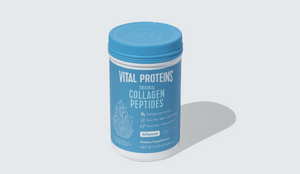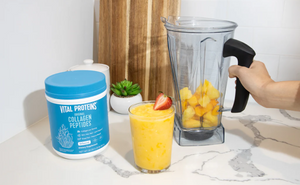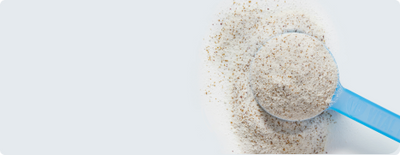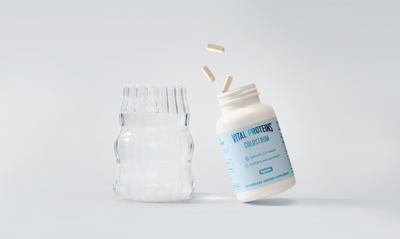It doesn't take a degree in cosmetology to know when your hair is unhealthy. You can usually tell just by looking at it or running your fingers through it. Split ends, lack of shine and brittle texture all are signs that your hair is in need of a little TLC.
So what can you do to fix unhealthy hair? We’ve got you covered with advice from hair experts. Read on for everything you need to know about hair repair so you can breathe new life into your locks.
Why Is My Hair So Unhealthy?
Seeing shiny, silky hair on someone else might make you look at your own locks and think, Why is my hair so unhealthy? While bleaching, heat from styling tools and exposure to harsh weather are all obvious culprits for damage, some lesser-known habits may be secretly causing trouble, too.
Your hair accessories, for starters, could be causing discomfort (think: a tight ponytail or firm bobby pins). "When hair suffers from excessive tension and tangling, scalp blood supply gets affected. As a result, hair doesn’t get enough nutrition," explains Nikki Goddard, a certified hairstylist and makeup artist with an associate degree in cosmetology.
The wrong hair products may also be at fault. Dawn Clemens, Founder of Larwe Hair, says to use products that complement your hair type. "For example, if you have dry hair, that is mainly because you’re using shampoos containing sulphates, which tend to make your scalp dry and take away the required amount of moisture one's hair or scalp needs."

How Do You Fix Unhealthy Hair?
Start by examining the root of the problem. To fix unhealthy hair, you need a solid hair care routine. In addition to using the right shampoo, conditioner and hair masks, Jamila Powell, Owner of Naturally Drenched, says that scalp care is key.
"Make sure you are using products that don’t have any ingredients that irritate your scalp," she says, adding that you may want to clarify the hair once a month (especially if those locks are parched). You may also want to use a protein or bond rebuilder if the hair is chemically processed (think: colored, bleached, etc).
And while you may have heard you should cut down on shampoo days, that's not always the case. "The truth is, you should perform washing as often as required by your hair type, even every day is okay," Goddard says. For example, if you have oily and thin hair, it may get dirty within 24 hours, so feel free to wash daily with safe shampoos, moderately warm water and conditioners.
This next one's a big ask, but restoring your strands means giving the hot styling tools a break. Can’t bear to separate from your blow dryer or flat iron? Goddard says to use thermal protectants. While you're at it, take a break from coloring or bleaching your hair and avoid harsh weather conditions if you can. Snow, wind, rain and cold air are all damaging conditions to avoid, says Goddard.
If you live in a cold climate, Goddard suggests protecting your head with a had made from natural materials (such as wool or cotton). And whenever possible, avoid going out in the cold with wet locks, as freezing can cause the strands to close structure and become dull and brittle. Additionally, use moisturizing products and be sure to use heat protectant when styling.
Finally, the answer to "how do you fix unhealthy hair" is refreshing your locks with a clean slate. For this, a trip to the salon may be in order, as Clemens says that your stylist can remove split ends and overgrowth (your need for this will depend on your last visit and current hair condition).
What Causes Unhealthy Hair?
Diet and lifestyle are major players when it comes to hair health, so you'll want to make sure you've got the right nutrients on your side, including zinc and A and B vitamins. "Lack of nutritious elements and vitamins also worsens the condition of the hair," says Goddard.**
Give hair the boost it needs with Vital Proteins Beauty Collagen® packed with collagen peptides, skin-loving hyaluronic acid and probiotics, which helps support hair, skin and nails.** You can also try Beauty Boost™ capsules, which contain biotin and vitamin C to help promote collagen synthesis.** As is the case with any supplement, check with your licensed healthcare professional before introducing a new supplement to your daily wellness regimen.
What Does Unhealthy Hair Look Like?
If you've experienced split ends, breakage or brittle strands — the sworn enemies of healthy hair — chances are you already know what unhealthy hair looks like.
According to Sadler, unhealthy hair looks dull and sometimes has many frayed ends that look almost dusty. "Conversely, it can look oily at the scalp and dry on the ends,” she explains. "It can be broken along the hair shaft or at the hairline."
Where there's unhealthy hair, there's frizz. "Unhealthy hair is quite easy to identify especially from the amount of split ends and frizz which can be seen from miles away," says Clemens.

What Should Healthy Hair Feel Like?
According to Kerry Yates, Founder and beauty inventor at Colour Collective, healthy hair should be soft to the touch, regardless of texture. While the hair should have shine, don't expect it to be just like the haircommercials: "Healthy hair should have a certain shine to it, not a high gloss but definitely not matte looking." Goddard adds that a chemical burn after coloring is manifested into excessive hair shine, so be sure to know the difference.
You'll notice a few things when you run your fingers through your tresses. "It's strong, soft, and easy to detangle," Goddard tells Lively. "Only a few hairs fall off when you brush or wash your head." Even how it interacts with your hair care products is different: "Healthy hair absorbs care products without becoming too soft, dry or oily," Goddard adds.
Finally, like a diamond, healthy hair, even if it's colored, should be brilliant. "Strands perfectly reflect sunlight. In the case of coloring, strands still radiate light."
What's The Worst Shampoo For Your Hair?
When it comes to hair products, shampoo is a non-negotiable necessity. It’s also non-negotiable that you get the right one. These are the ingredients and claims to avoid whens shopping for hair products, according to the hair experts.
-
Sulfates:This is what causes your shampoo to foam when you combine water. "It gives the illusion that it's actually making your hair cleaner, but the foam is not needed," explains Penny Sadler,a licensed cosmetologist and professional makeup artist. Look out for: ammonium lauryl sulfate, sodium lauryl sulfate, ammonium laureth sulfate, sodium laureth sulfate. Goddard says that they can cause irritation, dryness, itching, allergy and hair loss.**
-
"Detoxing Benefits": Yates says that shampoos touting this are often harsh to the scalp. “It strips the hair of essential oils that help maintain scalp health and lubricate each strand.”
-
Parabens: “(Benzoic acid derivatives) can penetrate through the skin's protective barrier and affect the level of estrogen in the body," says Goddard. Butylparaben and its derivatives are the most dangerous types of paragons. Sadler adds that a lot of people are actually allergic to parabens.
-
Sodium Chloride: Clemens says to leave any shampoo with this ingredient on the shelf. “Companies add salt in their shampoos to thicken their consistency, but they instead damage our hair by making the scalp more dry and itchy, which can lead to hair fall."
-
Mineral Oil: Look out for these hidden names in shampoos: phthalates, benzene, piettil glycol and formaldehyde.
What Are Signs Of New Hair Growth?
If you're hoping for a Rapunzel transformation overnight, you're going to be waiting a long time. "Hair grows slowly, on average 1/4 to 1/2 inch per month," says Sadler. But if you're on the hunt for signs of new hair growth, there are some surprising things to look for.
-
Hair Becomes Downy or Fuzzy: "Those are new hairs appearing on the scalp," explains Goddard. "They are shorter than the rest." Yates adds that they are usually called "baby hairs."
-
An Itchy Scalp: "Scalp itching takes place a few weeks or months before growing," says Goddard.
-
Frizz: The hair may look frizzy, but in this case, frizz isn't a bad thing. Sadler says that it's the result of a lot of new hairs coming in.
-
Black Spots On Scalp: New hair follicles in the anagen (active growth) phase can cause this, according to Goddard. You may also see light spots.
-
Hair Is Easier To Manage: "New hair is soft and smooth. It keeps shape better," says Goddard. This makes brushing and styling easier.















